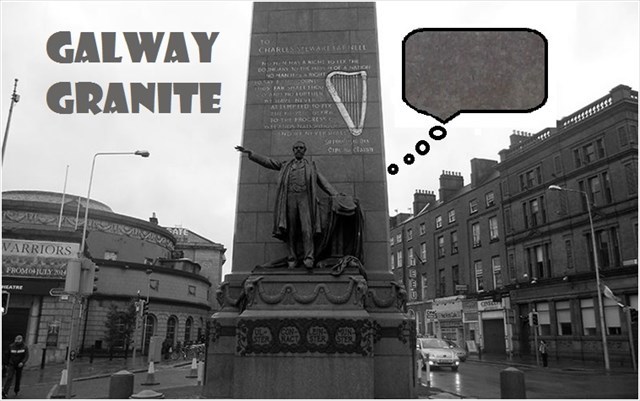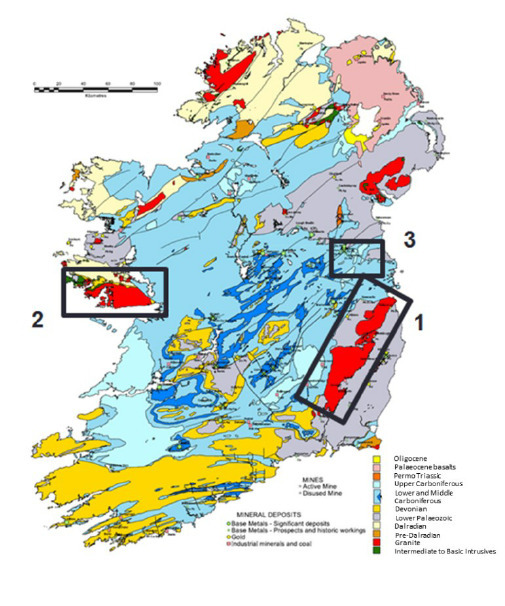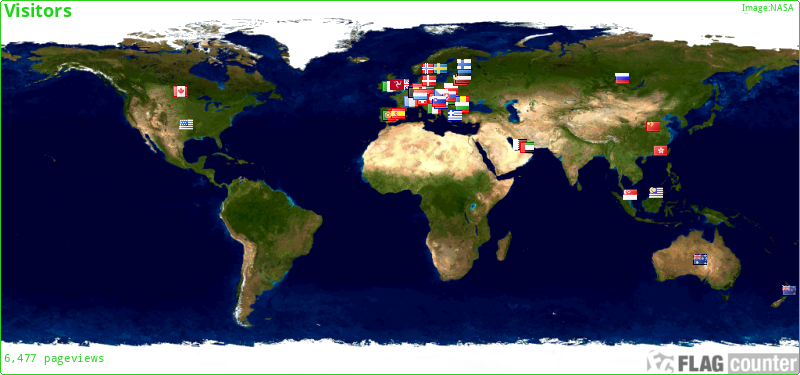
(Charles Stewart Parnell: Irish landlord, nationalist political leader, land reform agitator, and the founder and leader of the Irish Parliamentary Party.)
The learning point of this earthcache is to get the geocacher to become familiar with the rock granite. The granite is a characteristic and common rock species that is found worldwide.
Grand zero guides you to the Parnell Monument , a 57 ft high obelisk that is made by solid Galway granite. Like other granites, it can be classified as a magmatic rock, a deep rock species formed by solidification of stone melt below the ground surface.

Figure: Geological map of Ireland with survey areas marked: (1. Leinster Granite), (2. Galway Granite), (3. buried Kentstown Granite) (geological map modified from that of the Geological Survey of Ireland)
A granite stone in general:
Granite is a common type of felsic intrusive igneous rock that is granular and with visible crystals in its texture. Granites can be found in white, pink, or gray in color, depending on their mineralogy. The “normal” %-numbers given in the granite stone is between 20% and 60% quartz, referred to as the white glassy mineral, and at least 35% of the total feldspar, found as white till red pink-ish color, consisting of alkali feldspar, and the biotite (black mica). Commonly the term "granite" is used to refer to a wider range of coarse grained igneous rocks that containing quartz and feldspar and may have more reddish colors. While a less or non-reddish color refers more to a medium-grain, light gray, grey or blue-gray rock species.
Feldspar is crystallized (made / occurs) from magma in deep and extrusives ekstrusive. The size of the crystals tells us where and how far down into the crust they were made and formed. Easy said and explained, the larger the crystals are, the longer they have been forming, and the deeper into the crust they origin from. Feldspar is a vital element in magmatic rocks where the proportion and type of feldspar are used to classify the rock.
The Galway granite has paved its way into the surrounding bedrock as a stone melt (magma) and solidified into a solid rock deep below the surface.
The melting residues squeezed out onto the surrounding bedrock and formed pegmatite passages with giant crystals of feldspar and many other minerals, some of them rare.
Galway Granite:
(Special interest info)

The caledonian granites of Galway granite batholith - the Kilkieran sector, south Connemara, and western Ireland occupy a key location in the western Irish Caledonides. The granites comprise the Galway Granite Batholith and its satellite plutons of roundstone, Inish, Omey and Letterfrack. The granite's 80 km long, the west/northwest-trending axis reflects a stitching relationship between the granite and the east/west-trending Skird rocks fault which is one of a number of major strike-slip faults that parallel the Iapetus suture in the British and Irish Caledonides. The closure of Iapetus was between 450 and 400 Ma, the climax of the Caledonian Orogeny, raised great mountains in Scotland and Ireland.
Detailed geological mapping has identified five main granite types i.e. the Microgranite, the Glenaruid Layered Granite, the Megacrystic Porphyritic Granite, the Scainnimh Coarse Grained Granite and the Northern Coarse Grained Granite.
The Galway granite, an aphyric medium-grained alkali granite that occurs at the margin of the pluton, followed by a coarse porphyritic granite, which becomes more basic towards the granite centre found and based in the western and northern parts of batholith. Westwards the coarse porphyritic granite develops a foliation in which xenoliths and occasionally potash feldspar phenocrysts are aligned.
The zonation of the granite is thought to have resulted from crystallization of magma in which compositional gradients were set up during the early crystallization periode. A temperature gradient, decreasing from the centre of the magma chamber outwards into the rocks, resulted in the migration of water, accompanied by alkalis and other volatiles, towards the granite margin, also the early-crystallizing minerals displaced the residual magma outwards. Crystallizanation was followed by shearing in the deeper parts of the pluton to produce the granite foliation.
The biotite poor aphyric granite is pink weathering and has a grain size of 2-3mm, the rock at the more south part comes finer grained (1-2mm). The coarse porphyritic granite possesses characteristic pink k-feldspar and occasional plagioclase phenocrysts in a quartz oligoclase k-feldspar biotite groundmass that is average 5mm in grain size.
Mineral layering is a feature of the Galway granite. Biotite rich layers or bands occur in the coarse porhyritic granite. Some of these biotite layers have associated felsic bands. And at qurrys, layers like this can be found till up to 3m in thickness.
To log this cache.
To get to log this cache you will have to visit and answer the questions which are related to the coordinates given the earthcache.
When answers are collected, send them to CO for verification.
You can log immediately after answers are sent CO. If there are any questions about your answers CO will contact you.
Logs without answers to CO or with pending questions from CO will be deleted without any further notice.
Please do not include pictures in your log that may answer the questions.
Questions
1. Answer the questions under by visiting the Coordinates.
A. What are the mineral mixture made up by that you can see here in the stone? (looking for the 3 main sorts). What percentage would you say each of them represent in the stone?
B. B-1) Have a look out for the feldspar crystals here in the stone at gz, what size are they? B-2) And how can you easiest identify the feldspar? B-3) Fact about the crystals: the bigger the crystals are, the deeper down or higher up in the crust they origin from?
C. Describe the three monument sides here at gz, are they any different from each other? (Proportioned in minerals, grains, color ect..)
2. (It’s voluntary to post a photo in your online log of your visit)
Without revealing any answers!
